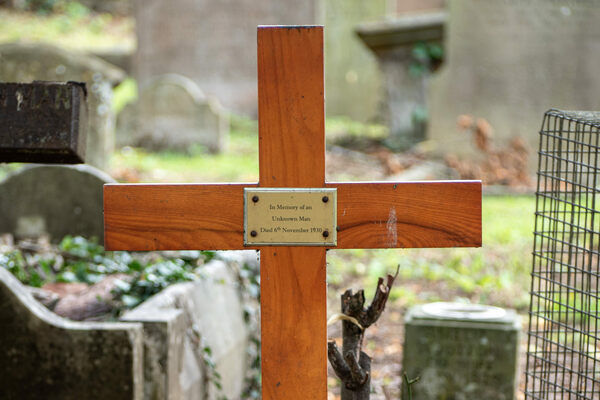In a small church cemetery In the village of Hardingstone, a wooden cross marks the final resting place of an unknown man who was the unfortunate victim of another man’s elaborate plan to fake his own death.
In the early hours of November 6, 1930, two young men spotted a fire in the distance as they walked to Hardingstone from a Bonfire Night event. They walked towards the fire and passed a neatly dressed man carrying a briefcase. The two men spoke to the stranger, who told them that someone must have lit a large campfire during the festivities the night before. The neatly dressed man then went on into the darkness.
When the young men finally reached the fire, they discovered that it was indeed a car that was engulfed in flames (more precisely, a Morris Minor). Inside the vehicle were the charred remains of an unknown man. They immediately notified the village police officer and extinguished the blazing flames with water from a nearby pond.
The forensic examination revealed evidence of tampering with the car, suggesting the fire was deliberately started. The man in the car was found to have died before it went up in flames as there was no smoke in his lungs. On the basis of the still intact rear license plate, the police determined that the car belonged to an “Alfred Rouse”. A nationwide press call was launched asking the neatly dressed man seen near the fire to come forward.
The police visited Rouse’s house where they interviewed his wife. Mrs. Rouse was asked if she could identify any clothes and a wallet that were found on the victim. She stated that the clothes were similar to her husband’s and that the wallet was definitely his.
Slowly but surely the whole story emerged: On the morning of the fire, the neatly dressed man – later identified as Alfred Rouse – had hitchhiked from Northamptonshire (the crime scene) to his home in London. He later traveled by train to Wales, where he met Phyllis Jenkins, one of his many lovers. She asked where Rouse’s car was and he replied that it had been stolen. What he didn’t know was that Jenkins had seen the news and recognized Rouse’s car in the photo. On his return to London, Jenkins contacted the police – Rouse was arrested while exiting the train.
Rouse told police that the car was his and that the whole ordeal was simply an accident, and even told authorities that he had made his way to Scotland Yard to report it to the police. He claimed he picked up a drunk hitchhiker and the fire started after asking his drunk passenger to fill the car with gasoline. Rouse told police that he also gave the man a cigar and that the car caught fire because the hitchhiker was drunk. Police presented Rouse with evidence of a bad game and showed that the car’s gasoline line had been deliberately tampered with, but he remained firm believers it was all an accident. However, when subjected to further questions, Rouse’s story changed several times and authorities realized he was guilty of the crime.
The murder trial of Rouse began in January 1931. Prosecutors argued that Rouse tried to fake his own death in order to avoid financial obligations. Rouse had fathered a number of children, which resulted in him having to pay child support. The jury found Rouse guilty and he was hanged in Bedford Gaol in March 1931. Prior to his execution, Rouse wrote a letter to the newspaper, the Daily Sketch, in which he confessed to the crime.
To this day, the identity of the man Rouse killed remains a mystery. He was buried in St. Edmunds Church in a grave marked with a wooden cross. The cross was paid for by the Hardingstone villagers who raised funds for the unfortunate person. The words “In memory of an unknown man” are engraved on the cross along with the date of his death.
In the past few years, some people have come forward who believed that there was a possibility that the unknown man was a missing relative. Each time the DNA results have returned as a negative match, and so the mystery of the man’s identity remains. Today the original cross has fallen into disrepair. It has been removed from the ground and rests on a tombstone. A new, smaller wooden cross with a brass plaque with a copy of the inscription of the original cross was placed on the site.

